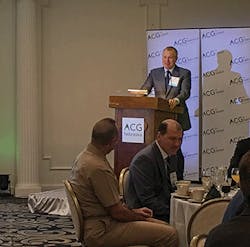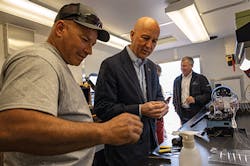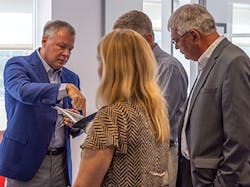Learn how century-old GPC focuses on the future with fiber network investment while ensuring that they address what really matters in their corporate culture.
Topic: HISTORY CHARTS THE FUTURE
ISE: Tell us about the history of Great Plains Communications (100+ years) and your commitment to enabling communications in local communities. How does that translate to the growth of your network and the new services that you offer today?
Foje: Great Plains Communications (GPC) started as a telephone company in Creighton, Nebraska, in 1910. As technology expanded over the past century, the company evolved with it, realizing that we needed to adopt a forward-thinking approach to innovation to not only help maintain our communities, but to also allow them to grow and thrive. This was the mindset that inspired us to begin deploying fiber in the 1980s, and what drives us to continue to invest in and improve our network and expand our service capabilities year over year. We continue this forward-thinking philosophy today as we increase our capacity and fiber footprint, and add to our product suite to meet the changing demands of our clients and the market.
GPC is a growing midwestern provider today with an expanding 13,500+-mile MEF-certified fiber network that reaches 11 states. We serve business and residential customers in more than 200 communities in Nebraska and Indiana with a suite of products that includes high-speed Internet, managed Ethernet, GPC Cloud Connect services, managed WiFi, video, traditional and cloud-based voice services, and DDoS mitigation.
We also take pride in our progressive approach to serving the unique needs of regional and national carriers, LECs, ISPs, wireless carriers, and other telecommunications providers, in our Carrier and Wholesale division of the business.
In addition, the company continues to advocate for increased broadband deployment to bring fiber-driven services to both urban and rural areas to support growth and economic development opportunities as a trusted community technology partner.
Topic: PRIORITIES
ISE: What are 3 of Great Plains Communication’s top network-related priorities in 2021?
Foje: Capacity, Reliability and Expansion
Capacity — The company continues to add more capacity to the network to meet the rising bandwidth demands in both homes and businesses, and the increasing needs of our carrier and wholesale customer base. This added capacity makes it possible for customers to upgrade quickly as their demands and needs change to position them for future success. Growing capacity also positions our company for success by allowing us to continue to meet the rising bandwidth demand that comes from technology evolution that is ever changing at a fast pace.
Reliability — By constantly investing in and making improvements to our network, we ensure greater reliability, which is a must for our customers. We currently offer 99.999% reliability on our core. The network is monitored 24/7/365 in our Network Operations Center located in our Blair, Nebraska, headquarters near Omaha to foresee and mitigate issues quickly.
Expansion — The company is dedicated to driving fiber further into the country, including both rural and urban areas to meet the needs of the market. As we learned in 2020, high-speed bandwidth, preferably through fiber-based services, is essential. Therefore, providers must strive to reach as many communities as possible to provide the ability to work and learn from home while ensuring that all devices, including smart home applications, telehealth, and cloud services, are readily accessible as our nation continues to rely on fiber-driven services and applications.
Topic: 5G — IT’S ALL ABOUT FIBER 5G
ISE: 5G will not only enable transformative new services — the Internet of Things, connected cars, telehealth, and precision agriculture — it will create economic productivity and jobs. But the future of wireless is inextricably linked to our ability to deploy fiber infrastructure across the country. If we want to bring economic productivity and jobs, we need to scale fiber and deploy more fiber to everyone. What are some creative solutions GPC is employing to help FTTx-to-Everywhere efforts?
Foje: Through our Carrier and Wholesale division, GPC serves all major national wireless providers and several regional providers by deploying Fiber-to-the Tower (FTTH) to support 5G and other up-and-coming technologies. Another way the company continues to deploy fiber is through utilizing our own construction company, Great Plains Underground Construction (GPUC). We are able to prioritize our projects and deploy resources to help meet construction goals with experienced crews and professionals working in close contact with other departments as a cohesive team.
Topic: GOVERNMENT FUNDING
ISE: What government funding programs does GPC currently participate in, and what do you see coming from those in the near future?
Foje: We are proud to partner with the programs (see below) to help support further broadband deployment to rural America. These policies implemented by our federal and state officials are enabling providers to bring high-speed and high-capacity fiber services to more rural areas.
2020 CARES Act is rural broadband funding administered by the State of Nebraska Department of Economic Development by which fiber-based broadband infrastructure has been deployed to 7 of our company’s rural communities, reaching more than 7,000 customers in 2020 and 2021.
Nebraska Legislative Bill 388, introduced in the current session by Governor Pete Ricketts, and recently approved, will provide $20 million annually toward broadband projects in the state of Nebraska this year and next.
The Federal Communications Commission’s Alternative Connect America Model program implemented in 2017, and expanded in 2018 and 2019, is the most important regulatory policy
decision for achieving broadband deployment for hundreds of rural carriers nationwide. A petition seeking extension of the program’s term to allow companies to reach more consumers sooner and with even higher speeds is currently pending at the FCC.
A rural broadband grant program that is to be administered by the National Telecommunications and Information Agency, a policy arm of the White House, will provide another $300 million nationally to build broadband to underserved rural communities in 2021 and 2022.
The Next Level Connections (NLC) Broadband Grant Program is designed to promulgate access to reliable and affordable broadband service to all areas of the state of Indiana, which is necessary for a highly functioning 21st Century economy. This is a part of Indiana Governor Holcomb’s broader Next Level Connections infrastructure program. (www.in.gov/gov/next-level-agenda/next-level-connections)
And finally, support from the long-standing Nebraska Universal Service Fund, approved more than 2 decades ago by the Nebraska legislature and implemented by the Nebraska Public Service Commission, provides targeted support to the state’s highest-cost areas, and demands accountability by recipient carriers for deployment and maintenance of broadband infrastructure.
Topic: PROACTIVE NETWORK MANAGEMENT
ISE: ICT industry analysts and observers often focuses on service providers’ CapEx budgets. But the reality is that OpEx can make or break a provider’s bottom line. The key to controlling OpEx is to improve network life cycle management for complex fiber, 5G, and legacy networks in a cost-efficient manner. What are some proactive approaches you recommend to help control OpEx?
Foje: A lot of focus is given to capital investment but managing operating and network cost is equally as important. Some of the key areas to manage include network cost, people cost, and efficiencies in processes and with automation.
We regularly evaluate our processes and the tools we use to identify efficiencies. It is a process with no end in sight. We find ourselves in frequent discussions about how we can do things better, faster, and more efficiently.
For example, if a company does not own its own network, then circuit or transport cost is a major spend. Upfront in the procurement process, it is important to obtain the best pricing with reasonable terms (12, 24, 36 months) as bandwidth prices continue to reduce over time. Utilizing circuits for a long-term contract may be a disadvantage.
Another strategy for 5G network Last Mile circuits is procuring bandwidth required today while forecasting future requirements and purchasing adequate capacity to support demand. (e.g., Start with 1G and aggressively price upgrades to 10G circuits in the initial procurement process.) Ultimately, a company building its own fiber (if feasible) may be another way to reduce network cost.
Another area of significant cost is the day-to-day operations and associated employees. It is important to ensure that operations are efficient, and that processes and tools are optimized. Inefficient processes can lead to over staffing. Having trained personal on staff or a combination of in-house and outsourced staffing can help.
Having tools to identify network issues helps to resolve issues quickly, and also reduces operations time and improves efficiency. Upgrading networks to the latest software release (or one release prior) will improve performance and reduce labor costs associated with software fixes.
Designing the network with redundancy and diversity, and building it efficiently reduces operational costs. This includes the planning of the facilities (central offices, huts, cabinets), requirements of the transport layers (Optical, Ethernet, and IP) and the fiber deployment (core and distribution counts). A well-designed network with growth in mind and services defined with automation ultimately reduces overall operating costs.
Topic: NETWORK AUTOMATION
ISE: ACG Research shared this: "Network automation is not a new concept, and most operators have already implemented some level of automation in their networks and operating environments. However, the level of automation currently in place is inadequate for the requirements of the market going forward. It is increasingly obvious that the market needs a much more comprehensive and pervasive level of automation in network infrastructure powered by intelligence implementation. The new level of automation must handle closed-loops as well as the capability to support full-cycle automation, enabled by A.I. This level is referred to as Autonomous Networks (AN)." Talk about Great Plains Communication’s plan and execution of AN in 2021-2022.
Foje: GPC agrees that automation is a key element of scaling its business. We have started that journey, leveraging technologies, and are in the initial phase of an end-to-end network automation strategy. The initial focus has been on provisioning and activation processes for voice and Internet services in the access or Last Mile network. The idea is to reduce the number of touches and to accelerate the order process to recognize revenue faster while also providing a better customer experience.
The other area of investment is the orchestration and the transport layer for Ethernet services and the implementation of Software Defined Networking (SDN) capability. Leveraging software and automation tools, we are implementing SDN capability to enable Network Automation for Ethernet, wave, Cloud and other services. The next phase will be automation of managed services with the introduction of virtualized services and others such as bandwidth on demand. The orchestration strategy and planned self-service portal will enable our customers to quote, order, activate, and manage, services end-to-end.
Topic: OVERLOOKED ISSUES
ISE: What should all of us in the Information and Communication Technology industry be talking about that we are not?
Foje: It is important to never let yourself or your company become complacent. Technology never sleeps and is always transforming and changing. Providers have to be constantly looking toward the future, monitoring the industry, and learning from their customers. The pace of change in our industry is not slowing down.
Topic: CULTURAL TRANSFORMATION
ISE: Explain why cultural transformation is as important as technical transformation to ensure that Communications Service Providers (CSPs) thrive in the future.
Foje: A company’s culture is exhibited by how its employees choose to interact with each other and with their customers and other stakeholders every day. Company culture is vital to ensuring that a company remains successful and healthy, both internally and externally, with a road map to doing business that defines them.
Culture is often described through the company core values but goes deeper than that. It defines the tone of the organizational family and helps set behavioral expectations. Culture also resonates a sense of pride within employees as they help to drive, nurture, and maintain, their company culture as a united team.
As valuable as a company culture is, it needs to be monitored, managed, and sometimes enhanced and changed, to continue to support the organization. It is important for leaders to be open to transforming areas of a company culture that could hinder success as needed, and be ready to drive that change throughout the organization to ensure adoption and success.
For instance, if a company finds they are not meeting goals because their current culture is based on a top-down decision-making process, they may need to consider changing processes and empowering employees to make decisions more quickly. Identifying the need for this cultural transformation and gaining buy-in from leaders and employees to make the change can create an even stronger culture that fosters greater success as the company continues to grow.
It is vital to recognize that culture drives results in multiple areas including achieving goals, staff empowerment, the ability to attract and retain talent, and effectiveness in the market. Being open to making changes through cultural transformation means being open to positive change, and that should be a part of every successful cultural strategy.
Topic: CONFLICT
ISE: How do you go about resolving conflict amongst team members?
Foje: Conflict can be healthy when it manifests in a manner where team members are sharing ideas and opinions about how to improve. We try to maintain a culture where anyone is free to share their ideas professionally and thoughtfully, even if unpopular. At times, conflict can rise to unhealthy levels, and we tend to confront the situation and ask the team members to speak to each other to find common ground. Nothing fancy, just old school communication.
Topic: IN PURSUIT OF KNOWLEDGE
ISE: What’s the best book you’ve read this year?
Foje: I found the book Leadership: In Turbulent Times by Doris Kearns Goodwin to be good, particularly considering our present political environment. She reflects on the lives and styles of 4 past Presidents: Abraham Lincoln, Theodore Roosevelt, Franklin D. Roosevelt, and Lyndon B. Johnson. She writes about how each showed leadership qualities and were recognized by others as leaders.
Topic: END-USER TRENDS
ISE: Discuss the less obvious end-user trends/needs/wants that are critical for telecom providers to meet both right away and in the future?
Foje: The need for cloud-based connectivity and products is very important in our current environment — especially for businesses. More and more users are working in remote environments with a need to access information quickly and from anywhere. Being able to meet that need with a reliable cloud product that allows business customers to realize a private connection to major cloud providers that bypasses public Internet traffic will provide increased efficiencies and a more secure and reliable cloud experience.
As cybersecurity attacks on businesses continue to increase, the demand for DDoS mitigation products delivered by telecom providers is also increasing. These products detect and defend against high-volume distributed denial of service attacks that block customers and employees from websites and applications, endanger business stability and profitability, and paralyze productivity.
Finally, automation and self-service customer portals are in demand to help clients access information about their network, allow for customers to upgrade and manage bandwidth according to unique and changing needs, and to contribute to a more convenient and satisfying customer experience. This information should be cloud-based, and available in real time, to help customers make decisions quickly and obtain information instantly.
InvisiLight® Solution for Deploying Fiber
April 2, 2022Go to Market Faster. Speed up Network Deployment
April 2, 2022Episode 10: Fiber Optic Closure Specs Explained…
April 1, 2022Food for Thought from Our 2022 ICT Visionaries
April 1, 2022Topic: CUSTOMER CARE
ISE: Companies that prioritize innovation and care in redesigning customer experiences will be best positioned to stay ahead of shifting consumer preferences. What are 2 of your top customer-centric tactics that you recommend to other providers that GPC does extremely well?
Foje: While some companies try to fit customers into a one-size-fits-all package, we work to understand the specific needs of our customers and then make recommendations that will help them realize their unique goals. From the first customer contact through deployment, turn-up, and maintenance, customers work with a local team of experts that continue to be their points of contact throughout their relationship with our company. This creates a high level of trust and an ability to help customers more quickly and effectively.
Although we are a geographically dispersed company with more than 200 communities being served across the Nebraska and Indiana markets, we pride ourselves on being good community partners. Over half of our 370 employees live and work in the communities they serve. In addition to this, our employees donate thousands of hours to causes and events in their hometowns, and the company donates a meaningful financial amount to the communities we serve. Truly being involved in giving back and taking responsibility as a community partner is vital.
Topic: HONESTY
ISE: What is it like to work for you?
Foje: This is a question probably best answered by others, but I’ll give it a try. We try to have a trusting and collaborative environment. I’ve been told that sometimes I’m too collaborative and should drive issues or decisions harder myself. At times I do. However, I usually find that consensus occurs, and the team can move ahead effectively together with everyone’s buy-in. We are growing quickly so the team is given lots of space to make decisions and move the business ahead, subject to keeping each other informed. We have formal executive meetings twice a month and other calls and meetings as needed on a variety of issues. We work hard at having good communication.
Topic: GROWTH
ISE: How do you see the industry growing? Public-Private Partnerships, acquisitions, etc.
Foje: I see the industry growing in several ways. One way is through converting communities and areas with dated delivery methods, such as converting copper or COAX customers to fiber, to allow for faster speeds and more capacity as the needs of business and residential customers continue to grow.
Another growth strategy is grant and government funding opportunities, including President Biden’s $65 billion broadband investment plan, and through partnering with public and private entities with matching funds to support fiber deployment.
Our company has a long history of partnering with policy makers in public-private partnerships to benefit our customers and further the policy goal of broadband for all. Along with identifying new markets to expand near existing fiber, I foresee the industry also growing through strategic mergers and acquisitions that allow providers to scale by expanding their reach, and to increase their customer base, fiber footprint, and talent pool.
References and Notes
https://www.whitehouse.gov/briefing-room/statements-releases/2021/06/24/fact-sheet-president-biden-announces-support-for-the-bipartisan-infrastructure-framework/
Source: Robert Sutton, author, and management professor at Stanford via www.inc.com.














